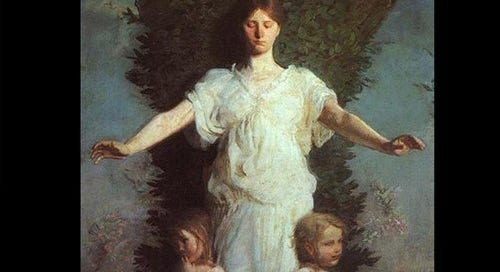Mary Wollstonecraft’s Vindication of the Rights of Woman (1792) is, using a term she employs numerous times throughout the book, an animadvert which challenges the second class status of women in the late eighteenth century. The work seeks to do more than merely discuss the social and political subjugation of women, however (though it discusses such matters in great detail). Instead, Wollstonecraft argues that the subservient status of women is morally corrupting to both men and women, as well as their children, and the author ultimately illustrates an argument that the equal status of women would move human history ever forward toward a more perfected society which the Enlightenment era purportedly sought.
Wollstonecraft aims her criticism at a number of prominent writers, philosophers, and religious thinkers, including devotional writer James Hervey and Scots Presbyterian minister James Fordyce, among many others. Probably the most recurring target, however, is Rousseau. Though clearly inspired by some aspects of Rousseau’s philosophy, Wollstonecraft is highly critical of his promotion of female subjugation. Using Rousseau’s “Sophia” to underscore his celebration of her never being able “to pretend to be the tutor of her husband,” Wollstonecraft uses this as a portal to examine the rampant hypocrisy among Enlightenment thought (and Enlightenment thinkers) more generally. In one example, she compares the absurdity of rationales of tyranny with the rule of men over women. “Let not men argue—as tyrannical kings have—that woman ought to be subjected because she has always been so” (132).
Her arguments return many times to what she sees as one of the most detrimental, and effective, aspects of female servitude: fondness for dress, jewelry, and fashion. She contends that a love for fashion by women who can afford such distractions is harmful to their intellectual growth and aids their bondage. Her criticisms are cutting and direct. Early in the book she asserts that an “air of fashion is a badge of slavery” (92). She later reasserts this position (though expanded to include other vices), maintaining that an “immoderate fondness for dress, for pleasure, and for sway, are the passions of savages” (311).
It is precisely the way personal vice interrupts and retards moral and intellectual maturity and advancement that Wollstonecraft sees as the corrupting influence. It is a corrupting influence that keeps women in a state of childlike ignorance. They remain drawn to frivolous ornamentation and insipid stories of romantic fiction. This state of arrested development is then rationalized by men to maintain social and political dominance. Keeping women ignorant of matters of the world reinforces their enslavement. Shallow pursuits keep them from pursuing their equal rights. Ornamentation, gossip, vapid reading materials, and the desire for adoration from men (for their appearance rather than for their faculties) ensure fidelity of the status quo.
Among the most substantial reforms advocated by Wollstonecraft is a system of national schooling which would educate every child through the age of nine for free. Wollstonecraft observes a problem with the exclusive quality of private education among the wealthy and lack of education among the majority of the population. Additionally, the national school system Wollstonecraft advocates would be co-educational, utilize school uniforms to avoid notions of social separation such as class, and would be run by committees made up of members of local parishes. She argues that every school of this kind should be surrounded by a large stretch of land. Physical outdoor play would be encouraged, and boys and girls would enjoy such play together. This is not a small detail in Wollstonecraft’s analysis, as she notes that the inability of young girls to enjoy physical play from a young age begins the process of defeating their independent spirit and equal status. In this school model, in which all disciplines of the arts and sciences would be taught to boys and girls alike, kids would not be sedentary in a classroom for more than an hour at a time. Children in these younger ages would not be given room and board but would instead return home each day, as the author contends that a child who sleeps at home learns to love their home and their family. This too is important for the larger society. “Few, I believe,” Wollstonecraft observes, “have had much affection for mankind, who did not first love their parents, their brothers, sisters, and even the domestic brutes, whom they first played with” (286 – 287).
Wollstonecraft’s conception of education would include a system of private secondary education or employment after children graduate from the public school. Older children and young adults would graduate to domestic employment, trade schools, or university—depending on intellect and ability. She maintains that such a model should continue under a co-ed approach, arguing that this would equalize the sexes, allow young people to choose their own life-companions, and encourage early marriage—which, when based on sexual equality, would be a social good.
Ultimately, the equality of women, Wollstonecraft reasons, is not merely about women but all of society. Women subjected to frivolous hobbies and concerning themselves only with how they can be desirous to men become bad mothers and bad citizens. The raising of girls who cannot play outside with boys implies their otherness in the culture and feeds a lack of independence. A lack of independence in the social sphere then rationalizes a lack of power in the political sphere. For Wollstonecraft, the subjugation of women is corrosive because it denies to them the opportunity to be learned and conscientious citizens. She makes the case that an enlightened society is one which allows women to not waste their potential on trivial habits and make a mockery of their faculties, engendering resentment. An enlightened society is one which pursues virtue, “nursed by liberty” (316). To obey the authority of reason, Wollstonecraft emphasizes, is to allow women as well as men the opportunity to pursue knowledge and virtue. Denying them their right to be virtuous citizens is to damn half the population to the bonds of ignorance.





